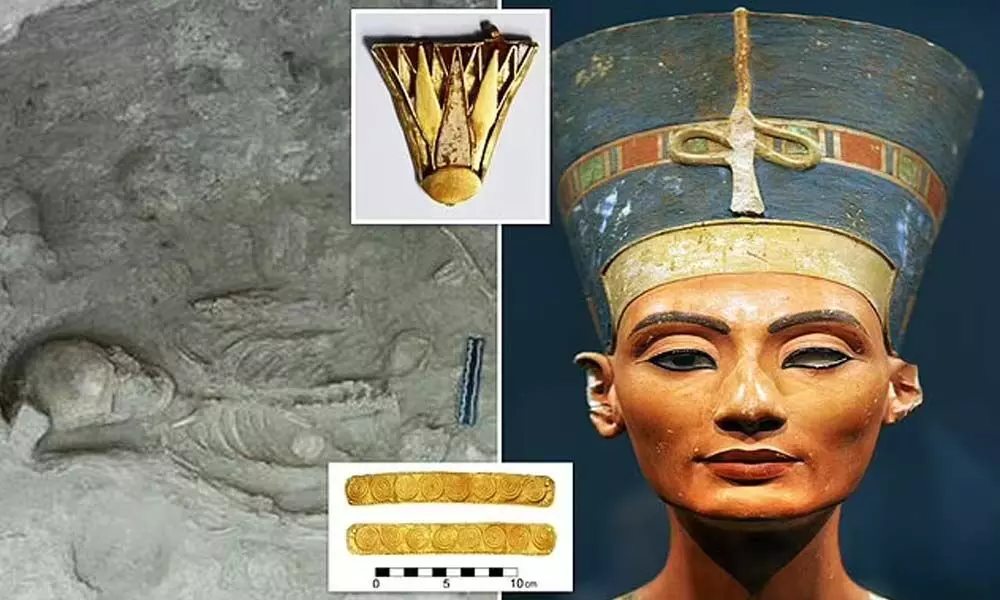Live
- ‘Dilruba’ team comes with first single ‘Aggipulle’ unveiled
- Legal drama ‘Court - State vs A Nobody’ set for March release
- Priyadarshi’s ‘Premante’ gets announced with grand launch
- Minister Jupally Reviews Rythu Bharosa Scheme Implementation in Nizamabad
- Wanaparthy collector reviews on survey of welfare schemes
- NDRF, NDA always come to rescue in case of disasters
- ‘Bhairavam’ teaser is just around the corner
- ‘Shiva Sambho’ blends culture and devotion in Telugu cinema
- Akash Jagannadh extends generous support to veteran Actress Pavala Syamala
- 'Attack' on Kejriwal: Atishi claims BJP wants to harm ex-CM, Parvesh hits back
Just In
Gold Jewelry From The Time Of Queen Nefertiti Has Been Discovered In Cyprus


Gold Jewelry From The Time Of Queen Nefertiti Has Been Discovered In Cyprus
- A valuable 'lotus blossom' pendant similar to one worn by ancient Egypt's Queen Nefertiti was discovered.
- In the graves, 155 human remains and 500 funerary artifacts were discovered, stacked on top of one another, indicating that the burial chambers had been utilized for multiple generations.
In a series of tombs in Cyprus, a valuable 'lotus blossom' pendant similar to one worn by ancient Egypt's Queen Nefertiti was discovered. Hundreds of magnificent burial goods from all over the Mediterranean region, including jewels, ceramics, and jewelry, have been discovered at the site.
The two Bronze Age tombs, both underground chambers, were discovered by archaeologists from the New Swedish Cyprus Expedition in the archaeological site of Hala Sultan Tekke in 2018. In the graves, 155 human remains and 500 funerary artifacts were discovered, stacked on top of one another, indicating that the burial chambers had been utilized for multiple generations.
Excavation leader Peter Fischer, professor emeritus of historical studies at the University of Gothenburg in Sweden mentioned that the discoveries imply that they are family tombs for the city's ruling class.
He further said that they discovered a 5-year-old's skeleton with a gold necklace, gold earrings, and a gold tiara. This was almost believed to be belonging from a certainly a wealthy and powerful family's child. The gold jewelry was dated by the archaeological team by comparing it to similar findings from Egypt. The analyses suggest that the majority of the artifacts date from around 1350 BCE, during the reign of Nefertiti and her spouse Echnaton.
He further added that they want to study the DNA of the skeletons placed in the tombs. It will disclose how the various individuals are linked to each other and if there are immigrants from another culture, which isn't unlikely given the wide trade networks.
Al bull made of ceramic was also discovered. This hollow bull's body has two openings: one on the back for filling it with a beverage, most likely wine, and one on the nose for drinking. They must have held feasts in the vault to commemorate their ancestors.
Gold, silver, bronze, and ivory jewelry, as well as objects, were found from diverse cultures, among the grave artifacts. Further grave treasures included a red carnelian gemstone from India, a blue lapis lazuli gemstone from Afghanistan, and amber from the Baltic Sea region - riches that suggest Bronze Age people in Cyprus were involved in a large commerce network.
As per the report, archaeologists discovered gold jewelry, scarabs inbeetle-shaped amulets with hieroglyphs, and the remnants of fish imported from the Nile Valley as proof of ancient Egyptian trade.
Meanwhile, a cylinder-shaped seal made of hematite, a metallic-colored mineral, was also discovered by the excavation crew. Archaeologists deciphered cuneiform writing from Mesopotamia on the seal. The paragraph is three lines long and includes three names. Amurru, a Mesopotamian god, is one of them. The other two are historical rulers, a father and a son, who we recently discovered in other clay tablets from a similar time period from the 18th century BCE.

© 2025 Hyderabad Media House Limited/The Hans India. All rights reserved. Powered by hocalwire.com






